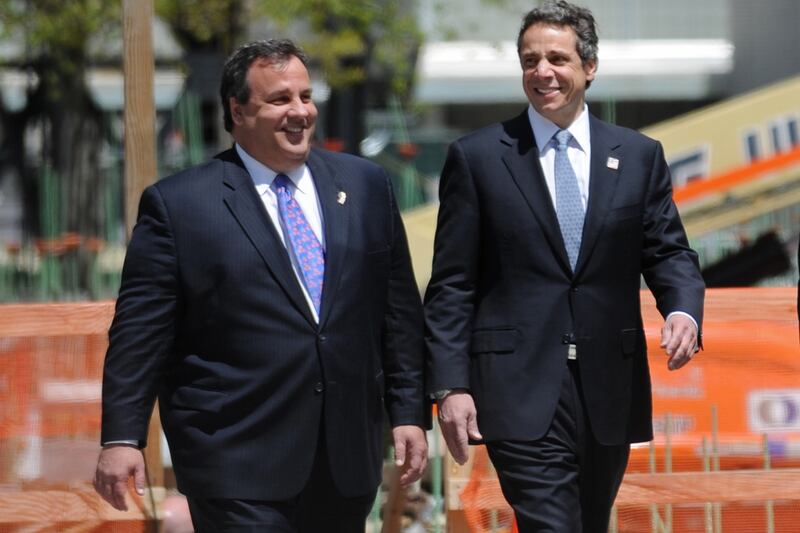Big storms have a way of throwing the incongruous together. Think of that carousel in the river, or the bar that washed up, intact, a few miles from where it once served customers. Or anarchists from Occupy Wall Street delivering aid alongside officials from FEMA.

Or, think of Chris Christie and Andrew Cuomo—the hard-charging, hands-on, ambitious governors from adjoining states—and opposing parties—now together like so many Sandy evacuees who found themselves on neighbors’ couches in the weeks after the storm.
It has all the makings of a titanic struggle over scarce resources and even scarcer public acclaim. But anybody looking forward to a Hudson River battle royale will be disappointed, say friends and advisers to both. In fact, when President Barack Obama toured New York in a helicopter with Cuomo two weeks ago, he warned the New York governor to avoid such a spat, telling him that the best way to get resources from a balky Congress was to team up together.
ADVERTISEMENT
Don’t worry, Cuomo told the president, according to someone told of the exchange. “The guy in the fleece and I get along great.”
Still, the two are locked in a situation that political observers say is unlike any they can remember. Two first-term, Italian-American governors, both in their 50s and who grew up 30 miles apart, and now are both tasked with helping their home states recover from a once-in-a-generation storm. They both need to pry the most resources as possible from Washington. And they are both widely seen as top contenders for their respective parties’ nominations in 2016, and so consequently need to differentiate themselves not just from each other but from every other like-minded pol in America.
“Politics does indeed create strange bedfellows,” says Doug Muzzio, a political-affairs professor at Baruch College in New York. “They have mutual interests and conflicting interests and, for now at least, the mutual interest outweighs a potential conflict in the long term.”
It is Christie who for months was unable to persuade GOP bigwigs that he didn’t want to run for president this year, and then who spent the rest of the year barnstorming the country to try to get Mitt Romney elected, a task that won him a keynote-speaker slot at the Republican National Convention. Cuomo, on the other hand, has hardly left the state at all since he has been governor, for fear of setting tongues wagging on his national prospects, and avoided speaking at the convention, or for that matter, campaigning for Barack Obama.
“You’ve got the guy whose strategy has been to go to the limelight like a moth, and the guy whose strategy has been to avoid the limelight like a bat,” says Muzzio.
Yet here they are. Part of the reason for the comity in the wake of Sandy is that they have been co-captaining the same ship for quite a while now. Cuomo and Christie share responsibility for the Port Authority of New York and New Jersey, the gargantuan bi-state agency that governs the region’s transportation network as well as the World Trade Center site. And they have given one another cover for the agency to raise tolls and over construction delays at ground zero. Before Cuomo took office, Christie set off a firestorm when he announced that he was killing a bi-state tunnel project for fears that it would cost too much. Elected officials on both sides of the river skewered him; Cuomo kept silent.
They also now, say aides to both, realize that neither Congress nor the public have much stomach at the moment for credit-hogging spats.
“These guys understand that the politics of the moment mean they have to do their jobs well, and they can only do their jobs well if they have a good working relationship,” says one operative who works on both sides of the river. “The public doesn’t want to see these guys scraping over every dollar.”
They haven’t appeared together yet, mostly because other than trips to Washington to ask for money they haven’t left their respective states much since the storm. And on Wednesday afternoon, they released a joint statement.
“Our economies and infrastructures are inextricably linked and, in many ways, dependent on one another, which is why we share common goals in the rebuilding effort,” it read. “It is our shared commitment to the people of our states to work in partnership so that our needs are met and we receive as much federal support as possible.”
For Christie, there is an immediate payoff. He will be running for reelection next year in a state that went for Obama by 17 points. Thus, he was seen all but bear-hugging the president after the storm, and it certainly doesn’t hurt to have the popular governor from across the way responding in kind. Anyone who has watched Cuomo’s two years as governor shouldn’t be surprised to see him doing the unexpected either.
“Andrew loves the odd play,” says one friend. “There is a contrarian streak in him.”
That is to say, the New York governor likes to play against type. He has one of the most famous names in Democratic politics, but he has refused to push for Democratic control of the legislature. He is thought to be the most ambitious of pols, but refuses to do any of the kind of things that ambitious pols do. He calls himself an “aggressive progressive,” but, like his counterpart across the river, he has frozen taxes and taken on public-sector unions.
The bi-state buddy act will come to nothing, however, if they aren’t able to pry dollars they need from Washington. The region has been through this before: after the 9/11 attacks, with public sentiment and President George W. Bush on his side, Gov. George Pataki asked for $54 billion in recovery dollars. The proposal was laden with money for only tangentially related projects, like high-speed rail and tax incentives to lure businesses to the state. Despite a favorable national mood, the request had trouble getting through Congress.
“There was still a lot of reticence from folks around the country, ‘Oh New York is a rich state, you are asking too much, we don’t trust what you are going to do with it’” recalls David Catalfamo, a top Pataki aide at the time.
Now, however, Cuomo and Christie are coming to Washington in a very inhospitable climate, with the federal government again on the brink of shutdown, and a decent chance that even current obligations won’t be met. When Cuomo announced that the state needed $30 billion in storm relief, some members of New York’s congressional delegation bristled, saying they hadn’t been told about it and would be forced to fight for a figure they didn’t construct. Truth is, they hadn’t; but the whole point of naming the figure was just to keep the heat on Washington.
“That was just ruffled egos down here,” says one senior Capitol Hill aide. “It was just a figure. I don’t know what people expected.”
Days later, that number got upped to $41 billion, with $9 billion ear-marked for storm-prevention infrastructure. The next day, Christie made the same point, asking Congress for $37 billion to help his state recover, a figure that exceeds the state’s entire budget. Both numbers now come up hard against congressional sausage-making. It will be the buddy’s act biggest test, at least until the Iowa caucuses begin in earnest.
“A number has been established,” says another senior congressional aide. “Now it’s all about getting the boulder up the hill.”






